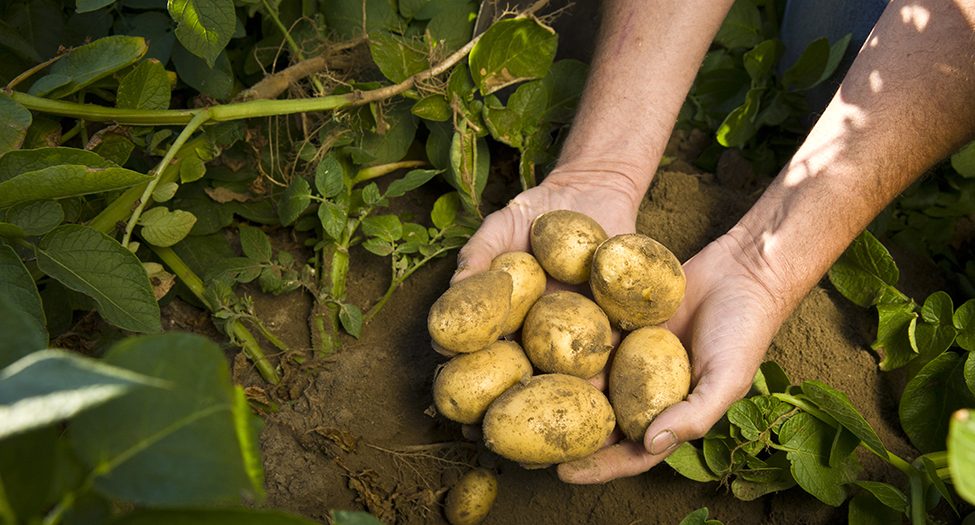
Home » Popular potatoes: Spuds stay big business for state
Popular potatoes: Spuds stay big business for state

June 12, 2019
The sweetest words a potato farmer in Eastern Washington can hear aren’t about crop yields or perfect weather or the opening of new processing plants.
Nah. What really rings golden is: Taco Bell is bringing back Nacho Fries.
Or: McDonald’s now has all-day breakfast.
And then there’s “loaded” fries, those deep-fried potato strips slathered in all manner of toppings, from cheese to bacon, that are all the rage in fast food.
Yes, these tasty taters are music to the ears of Eastern Washington potato farmers, the biggest suppliers of frozen french fries, tater tots and those little hash brown patties Americans can’t stop ordering with their all-day breakfasts.
“Whoever thought that dipping french fries in cheese sauce …?” pondered Chris Voigt, executive director of the Washington State Potato Commission.
Demand has been hard to meet. “Literally, the last five years, customers overseas have been rationed. We have not been able to meet the tremendous demand overseas” because of the increased domestic demand.
Processors are expanding, and that’s good, but it also can be challenging for us, too,” he said.
It’s big business.
Washington farmers grew 10.5 billion pounds of potatoes on 165,000 acres in 2018, worth $700 million. Processors take those hundreds of millions of dollars of potatoes and turn them into billions in frozen product.
The entire industry is worth about $7.4 billion to the state, Voigt said.
McCain Foods recently announced a $300 million expansion to its Othello plant, which will give the Columbia Basin another 14 potato processing lines. The addition, expected to be completed in 2021, will add 180 jobs and require an additional 11,000 acres of potatoes.
And it comes on the heels of Lamb Weston opening new plants or lines in Boardman in 2014, Richland in 2017 and Hermiston this year.
“Guess what?” Voigt asked. “We’re out. We can’t grow any more potatoes.”
Voigt went on to add a caveat to his comment. Eastern Washington growers can’t get there … yet.
It’s not as simple as planting more acres, he said.
Potatoes can’t be grown in the same field year after year. They need a four-year rotation: grow potatoes one year, then switch to another crop
for three years, then get the potatoes planted again. The biggest reason for the rotation is fungal growth. Verticillium wilt is a dire concern.
Also, because of the huge investment to get started — tens of millions of dollars of specialized equipment to plant and harvest potatoes — don’t expect a sudden influx of new farmers breaking ground in new areas.
“We think we’ll see some increases in acres,” Voigt said, “but it will put pressure on rotations.”
The big push now is figuring out how to increase yields and possibly find a way to shorten the rotation. In other words, soil management.
In that vein, farmers and processors are working with Washington State University, investing $3 million to aid in research.
Voigt said every farmer can tell the same story: plant in a field that hasn’t grown potatoes in 10 years, and the return is huge. Come back three years later, and it’s down a bit. Same thing three years later.
“How can we replicate that field that has not had potatoes in it for 10 years?” he asked.
The belief is it boils down to microorganisms — bacteria, fungi and the like. Think of it like probiotics in the human digestive system. The push is to find the right “yogurt” to help make those 10-year yields occur more frequently.
The other area of focus is irrigation: more potatoes need more water and that water comes from the Columbia River. Voigt said the industry is working with state and federal lawmakers in this area.

Last year was a “disappointing” year for Eastern Washington growers. Disappointing in that it didn’t turn out to be the huge bumper crop expected after such a great start to the growing season.
“It didn’t turn out nearly as well as we had hoped and thought it was going to do,” said Dale Lathim, executive director of Potato Growers of Washington, as well as president of the Potato Marketing Association of North America.
“It was shaping up to be the best crop ever. However, the heat and the smoke (from wildfires), all those things have impacts. You can’t put a finger on any one thing, but the full-season varieties harvested in September and October, in some cases, were disappointing. Not bad, just disappointing.”
When it comes to potatoes in the Columbia Basin, “disappointing” is a relative term.
“When we talk about having an off year,” Lathim said, “the rest of the world is hoping for that as their best year. It wasn’t the economic home run that we had hoped. But there were a lot of singles and doubles.”
This year’s crop is taking a different path from last year’s. The season started late because of all the snow in January and February. Homeowners may be able to shovel their driveway, but that doesn’t work so well in the fields.
“Usually we start planting the crop in the latter few days of February, and by the first of March you’re going,” Lathim said. “This year, I don’t believe a single potato was put in the ground until the 18th or 20th of March, a good full three weeks behind.”
What really threw farmers for a loop was that those closer to Othello were planting sooner than those near Pasco — an unheard of schedule.
Though it sounds like a dire forecast, the weather broke, temperatures hit above normal later in the spring and — very importantly — there were a lot of warm nights.
Suddenly three weeks late became five to seven days behind schedule.
But what really eases any weather-related pain is the fact that 90 percent of the potatoes grown in the Columbia Basin go to processing at one of the 13 (soon to be 14) plants in the area.
The processors anticipate delays and move back startup times, Lathim said.
Though there likely is no bumper crop, major losses, if any at all, are unlikely. That’s because for the farmers and the processors, it’s in their own best interest for each to succeed.
“The potato industry is unique,” Lathim said. “It’s a symbiotic relationship between the growers and the processors.”
It’s simple, really.
Farmers have tens of millions of dollars invested in equipment that does one thing and one thing only: plant and harvest potatoes.
Processors have hundreds of millions invested in equipment that does one thing and one thing only: process potatoes.
“I’ve been in the industry for 26 years, and I’ve been all over the world in agriculture,” Lathim said. “I’ve never seen another industry like the potato industry, especially here in the Columbia Basin.”
Because of the relationship between processors and farmers, and the world’s seemingly endless fascination with frozen potatoes, the trade battles and tariffs in recent years haven’t taken much of a bite out of the industry’s bottom line.
Any international loss of market was easily displaced by domestic demand — thank you Nacho Fries and all-day breakfasts.
Also, despite tariffs, the international market is still growing — exports to China are up 6 percent, Voigt said. However, the European Union’s exports have increased by 19 percent, so competition is growing.
Still, Voigt said, Columbia Basin growers have an edge — a Walmart-like edge.
“We have the highest yields in the world,” he said. “That makes us the low-cost provider. That’s why we have all the potato processors in this state.”
Agriculture + Viticulture
KEYWORDS focus agriculture viticulture 2019




